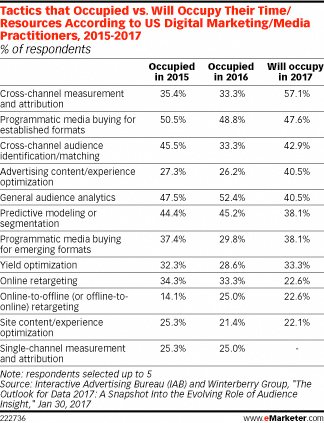The Challenges of Reaching an Omnichannel Audience
July 6, 2017
![]() Marketers are all pushing for an omnichannel, holistic view of their audiences, but that vision requires integrating audience insights from three core areas: TV, digital and in-store. And that poses substantial challenges.
Marketers are all pushing for an omnichannel, holistic view of their audiences, but that vision requires integrating audience insights from three core areas: TV, digital and in-store. And that poses substantial challenges.
 “The integration of disparate data sets, systems, vendors and technologies poses obvious challenges. At many companies, the need for organizational overhaul is less obvious, yet also vital,” said Lauren Fisher, principal analyst at eMarketer and author of the new report “Integrating TV, Digital and In-Store Data: The Pursuit of a True Omnichannel Audience.”
“The integration of disparate data sets, systems, vendors and technologies poses obvious challenges. At many companies, the need for organizational overhaul is less obvious, yet also vital,” said Lauren Fisher, principal analyst at eMarketer and author of the new report “Integrating TV, Digital and In-Store Data: The Pursuit of a True Omnichannel Audience.”
A January 2017 poll of US digital marketing and media practitioners conducted by the Interactive Advertising Bureau (IAB) and the Winterberry Group found the greatest portion of respondents planned to devote time and attention to cross-channel measurement and attribution in 2017. Cross-channel audience identification and matching was also mentioned by nearly half of marketers.
“The No. 1 reason why clients are interested in cross-channel is they want to get out of focusing on silos and want to start looking at customers holistically and messaging them across all mediums,” said Jared Belsky, president of digital advertising agency 360i. “They want to get out of their own siloed budgeting channels, like, ‘This is my ecommerce budget,’ or ‘This is my in-store budget,’ when it really should be, ‘How do I use marketing dollars to move consumers through the funnel to buy more goods.’”
As most marketers have found, successful integration of TV, digital and in-store data is only partially about combining all the necessary pieces. Navigating organizational and technology-driven obstacles is also a must.
Without organizational cooperation—and in many cases, digital transformation—any efforts aimed at integrating technology and data are in vain.
“Integrating data sets is about a marketing organization’s decision to invest in a data link of their own—a data infrastructure that pulls together the requisite data from all pieces of finance and marketing to different channels that are being managed across TV, digital, etc.,” said Michael Cohen, head of data and analytics at Convertro, an attribution firm owned by AOL. “That one piece of an investment can take a couple of years for an organization to achieve. But then there’s other work to be done, in terms of designing an organization that aligns with the underlying decision to support technology.”
Organizational realignment around technology initiatives is as important as it is difficult. A Q2 2016 survey of business professionals worldwide conducted by Harvard Business Review Analytics Services found that in many instances, respondents said the highest barriers to company use of digital technologies had to do with organizational and people-based challenges.
“The biggest challenge marketers will have over the next 10 years is investing in the resources and people to make those systems work well together and cohesively on their behalf,” said Joe Kyriakoza, vice president and general manager of automotive and TV solutions at Oracle.
In the latest episode of “Behind the Numbers” eMarketer analysts Lauren Fisher and Yoram Wurmser talk about how well marketers are doing in their quest to integrate digital, in-store and traditional media usage data.































